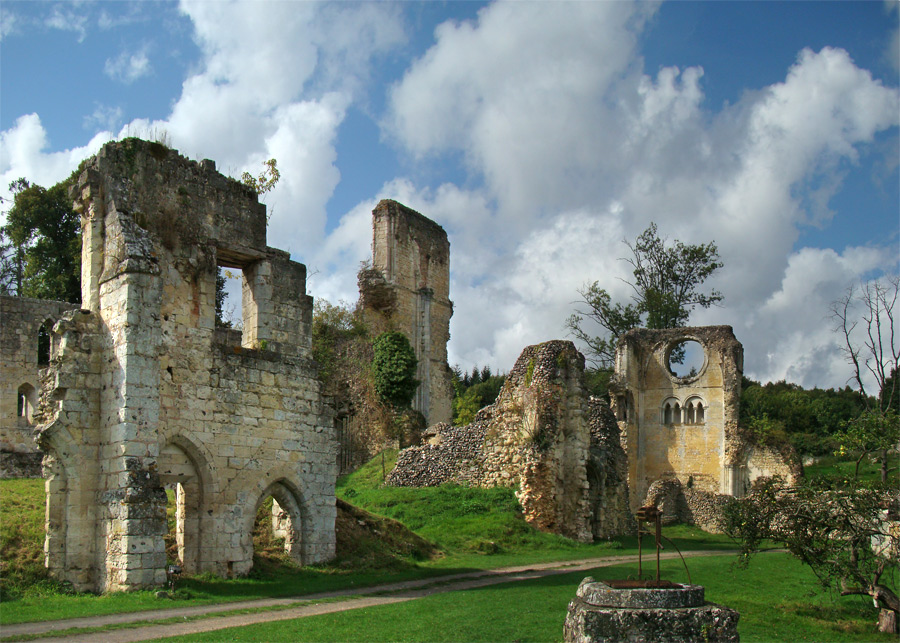Mortemer Abbey on:
[Wikipedia]
[Google]
[Amazon]
 Mortemer Abbey (, ) is a former
Mortemer Abbey (, ) is a former
 Mortemer Abbey (, ) is a former
Mortemer Abbey (, ) is a former Cistercian
The Cistercians (), officially the Order of Cistercians (, abbreviated as OCist or SOCist), are a Catholic religious order of monks and nuns that branched off from the Benedictines and follow the Rule of Saint Benedict, as well as the contri ...
monastery
A monastery is a building or complex of buildings comprising the domestic quarters and workplaces of Monasticism, monastics, monks or nuns, whether living in Cenobitic monasticism, communities or alone (hermits). A monastery generally includes a ...
in the Forest of Lyons between the present Lyons-la-Forêt
Lyons-la-Forêt () is a commune of the Eure department, Normandy, in northwest France. Lyons-la-Forêt has distinctive historical geography, and architecture, and contemporary culture, as a consequence of the Forest of Lyons, and its bocage, and ...
and Lisors, some southeast of Rouen
Rouen (, ; or ) is a city on the River Seine, in northwestern France. It is in the prefecture of Regions of France, region of Normandy (administrative region), Normandy and the Departments of France, department of Seine-Maritime. Formerly one ...
in the department of Eure
Eure ( ; ; or ) is a department in the administrative region of Normandy, northwestern France, named after the river Eure. Its prefecture is Évreux. In 2021, Eure had a population of 598,934.commune of Lisors.
Vidéo sur l'abbaye (1993)
(in French)
Site officiel de l'abbaye de Mortemer
(In French)
Further information on the abbey, its legend and ghosts, with images.
(Eng.) {{Authority control Cistercian monasteries in France Christian monasteries established in the 1130s Buildings and structures completed in 1134 1790 disestablishments in France Monasteries dissolved during the French Revolution Buildings and structures in Eure Ruins in Normandy Tourist attractions in Eure Ruined abbeys and monasteries
History
It was originally built in 1134 on land presented as a gift to the Cistercians byHenry I of England
Henry I ( – 1 December 1135), also known as Henry Beauclerc, was King of England from 1100 to his death in 1135. He was the fourth son of William the Conqueror and was educated in Latin and the liberal arts. On William's death in 1087, Henr ...
. The stagnant water of the drainage lake, dug out by the monks to dry up the marshy land around the quick-running Fouillebroc stream, was called the "dead pond" - in French "morte mare" - and gave the monastery its name. The monks constructed what was then one of the largest Cistercian monastery in the world.
Over the centuries, the abbey fell into decline and disrepair. It was rebuilt in the 17th century, but the decline was irreversible and by 1790, when it was dissolved in the course of the French Revolution, only five monks remained.
Buildings
The 12th-century buildings were already more or less derelict by the time of the French Revolution, and subsequent use as a convenient source of cut stone for local construction reduced them to little more than a ruin. Apart from the cloisters, which are relatively intact, there remains only a shell. The 17th-century buildings by contrast are well preserved and open to visitors, with guided tours available most of the year. The abbey site also has a well-maintained 17th-centurydovecote
A dovecote or dovecot , doocot (Scots Language, Scots) or columbarium is a structure intended to house Domestic pigeon, pigeons or doves. Dovecotes may be free-standing structures in a variety of shapes, or built into the end of a house or b ...
, which was also used as a gaol house in the 18th and 19th centuries.
Legends
There are a number of legends and ghost stories relating to the abbey.Matilda of England
Empress Matilda (10 September 1167), also known as Empress Maud, was one of the claimants to the English throne during the civil war known as the Anarchy. The daughter and heir of Henry I, king of England and ruler of Normandy, she went to ...
was forced by her father Henry I to stay in a room in the abbey for 5 years. After her death in Rouen
Rouen (, ; or ) is a city on the River Seine, in northwestern France. It is in the prefecture of Regions of France, region of Normandy (administrative region), Normandy and the Departments of France, department of Seine-Maritime. Formerly one ...
, she is said to have come back to haunt the place. Her ghost is known as ''The White Lady''. Visitors to the abbey have reported hearing strange noises and feeling a strange presence.
Four monks were murdered during the French Revolution and their ghosts are also said to haunt the abbey. If you meet a cat in the ruins, it is alleged to be a Goblin cat (), guarding the treasure of the abbey. There are a number of other legends, giving the abbey the nickname of as ''most haunted abbey in France''.
External links
Vidéo sur l'abbaye (1993)
(in French)
Site officiel de l'abbaye de Mortemer
(In French)
Further information on the abbey, its legend and ghosts, with images.
(Eng.) {{Authority control Cistercian monasteries in France Christian monasteries established in the 1130s Buildings and structures completed in 1134 1790 disestablishments in France Monasteries dissolved during the French Revolution Buildings and structures in Eure Ruins in Normandy Tourist attractions in Eure Ruined abbeys and monasteries